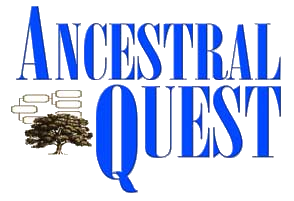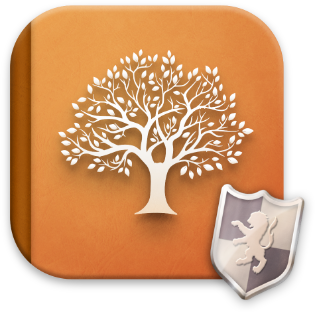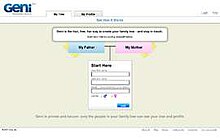GEDCOM, complete name FamilySearch GEDCOM, is a de facto open file format specification to store genealogical data, and import or export it between compatible genealogy software. GEDCOM is an acronym standing for Genealogical Data Communication. GEDCOM was developed by the Church of Jesus Christ of Latter-day Saints as an aid to genealogical research. Most genealogy software supports importing from and exporting to GEDCOM format.

PhpGedView is a free PHP-based web application for working with genealogy data on the Internet. The project was founded and is headed by John Finlay. It is licensed under the GPL-2.0-or-later license.
Genetic genealogy is the use of genealogical DNA tests, i.e., DNA profiling and DNA testing, in combination with traditional genealogical methods, to infer genetic relationships between individuals. This application of genetics came to be used by family historians in the 21st century, as DNA tests became affordable. The tests have been promoted by amateur groups, such as surname study groups or regional genealogical groups, as well as research projects such as the Genographic Project.
FamilySearch is a nonprofit organization and website offering genealogical records, education, and software. It is operated by The Church of Jesus Christ of Latter-day Saints, and is closely connected with the church's Family History Department. The Family History Department was originally established in 1894, as the Genealogical Society of Utah (GSU); it is the largest genealogy organization in the world.

Genealogy software is computer software used to record, organize, and publish genealogical data.

Gramps is a free and open-source genealogy software. Gramps is programmed in Python using PyGObject. It uses Graphviz to create relationship graphs.
This article compares several selected client-based genealogy programs. Web-based genealogy software is not included.
The Master Genealogist (TMG) is genealogy software originally created by Bob Velke for Microsoft DOS in 1993, with a version for Microsoft Windows released in 1996. Data entry was customized through the use of user-defined events, names, and relationship types. Official support for TMG ceased at the end of 2014. Informal support continues through a number of online user groups.

GenoPro is a software application for drawing family trees and genograms. GenoPro can store additional information such as; pictures, contacts, places, sources, occupation and education history for each individual, as well as document the relationships among individuals.
MyHeritage is an online genealogy platform with web, mobile, and software products and services, introduced by the Israeli company MyHeritage in 2003. Users of the platform can obtain their family trees, upload and browse through photos, and search through over 19.9 billion historical records, among other features.

Ahnenblatt is a genealogy software application for Microsoft Windows developed by German programmer Dirk Böttcher. It features data entry, plausibility check and creation of charts and reports. The software imports and exports GEDCOM files and exports Web pages.

Genbox Family History is genealogy software for Microsoft Windows, developed by Thoughtful Creations. It functions as a database, a research planner and task organizer, a data analyzer, a chart producer, and a report writer.

Rodovid is a free online collaborative family tree portal. Originally a Ukrainian project, as of 2023 it had active communities in 25 languages. It provides a web service built using MediaWiki and its own Rodovid Engine software to help store and visualize family relationships.

Ancestral Quest (AQ) is a genealogy software application for Microsoft Windows developed by Incline Software, LC. It features data entry with sourcing capabilities and scrapbook extensions; a print engine for standard or custom charts and reports; a web page creator; a collaboration engine; and an extension tool for other genealogy databases.

MacFamilyTree is a commercial genealogy program for macOS which allows users to build family trees and document genealogical research by adding data about family members including pictures, documents, and sound clips. It provides integration with iCloud to synchronize data across multiple devices and features the ability to generate and publish HTML web pages from saved family trees.

WeRelate.org is an American wiki genealogy website that provides genealogy tools and data. WeRelate is a non-profit and is funded by tax-deductible donations and is managed by unpaid volunteers. WeRelate had over 2 million person pages by March 2011 and claimed to be the "world's largest genealogy wiki".

Kith and Kin Pro is genealogy software for computers running Microsoft Windows. The program aids family historians by storing, querying and documenting family history. Developed by SpanSoft, Scotland, the software is distributed as shareware with a free trial period of 30 days.

TreeDraw is a genealogy program for computers running Microsoft Windows. The program is a chart editor which aids family historians in creating and printing family trees. Developed by SpanSoft, Scotland, the software is distributed as shareware with a free trial period.

WikiTree is a genealogy website that allows users to research and to contribute to their own family trees while building and collaborating on a singular worldwide family tree within the same system. WikiTree is free for the user and financed via advertisements displayed to unregistered users. WikiTree is owned and hosted by founder's company Interesting.com, Inc.
Yaniv Erlich is an Israeli-American scientist. He formerly served as an Associate Professor of Computer Science at Columbia University and was the Chief Science Officer of MyHeritage. Erlich's work combines computer science and genomics.












